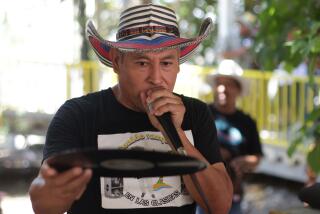Footsteps of Time Bypassing Chile’s ‘Town of Stairs’
- Share via
SEWELL, Chile — This old mining town high in the Andes has no streets. It has stairs.
Its houses and shops spread across two mountain slopes at an elevation of 7,250 feet, too steep for vehicles. Seen from a distance, the town looks like a huge pyramid of steps flanked by buildings painted in vivid colors of green, yellow, red and blue.
There is little life in the “Town of Stairs” these days, though. Improved highways made it easier to travel to the nearby mine from towns lower down the mountains, and residents drifted away over the years. Only a few hundred people come to work during the day.
Still, Chileans are striving to restore a town that played a historic role in the birth of the copper industry, which provided the country’s main export. The government, which declared the town a national monument in 1998, hopes to persuade UNESCO to add it to the U.N. agency’s list of World Heritage sites.
Sewell was founded a century ago as home for hundreds of miners who worked the shafts at nearby El Teniente, the world’s largest underground copper mine.
The town got its formal name in 1915 from Barton Sewell, an American executive for Braden Copper, the U.S. company that developed the mine and owned it until 1971.
That year, the mine was nationalized by Salvador Allende, Chile’s socialist president who was toppled two years later in a bloody coup that ushered in 17 years of military rule.
Sewell, 85 miles southeast of Santiago, had more than 15,000 residents at its peak. It began losing people in the late 1960s as miners began moving to the more comfortable city of Rancagua, which is closer to the capital and 40 minutes away by car.
Advances in mining technology have also reduced the need for workers. Only a few hundred miners make the trip up from Rancagua each day, but they dig out 435,000 tons of copper ore a year, nearly a quarter of Chile’s total output, worth $14 billion in 2004.
About 80% of Sewell’s industrial buildings and a third of the houses still stand.
Several structures have already been restored, such as the old hospital, which is used as a casino, and the former school, which houses a mining museum. But many show only a decaying facade.
More to Read
Sign up for Essential California
The most important California stories and recommendations in your inbox every morning.
You may occasionally receive promotional content from the Los Angeles Times.













